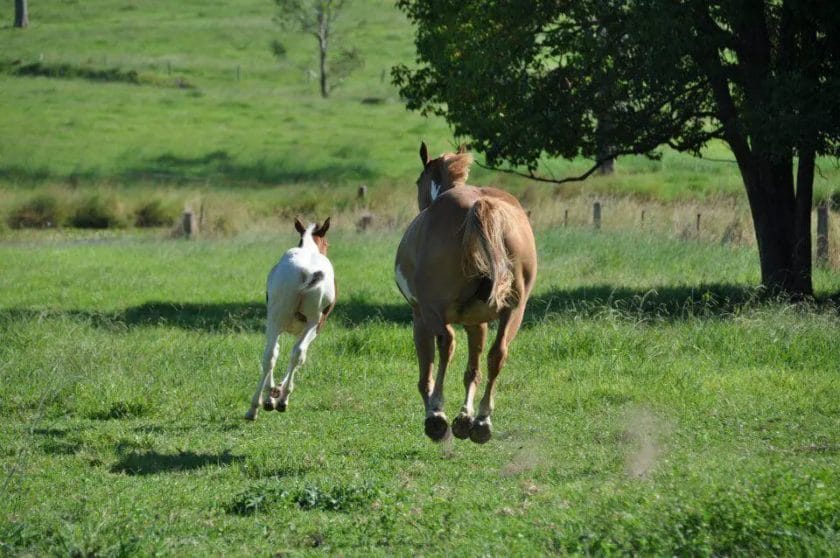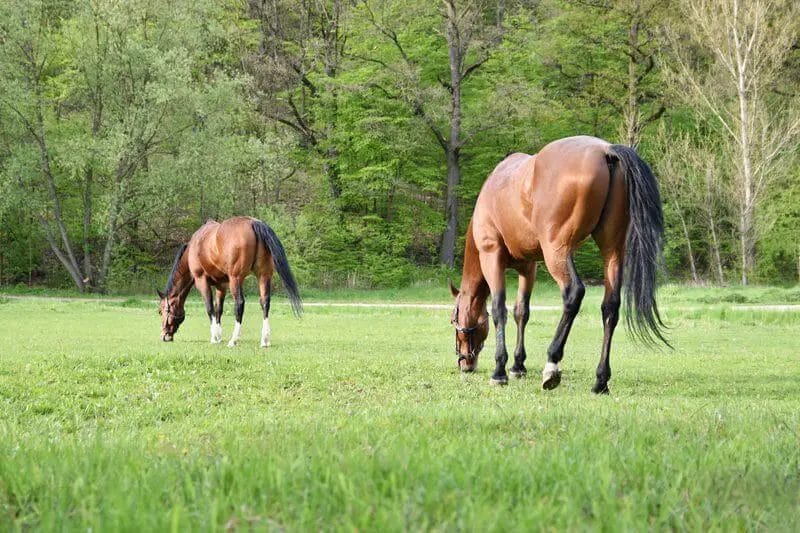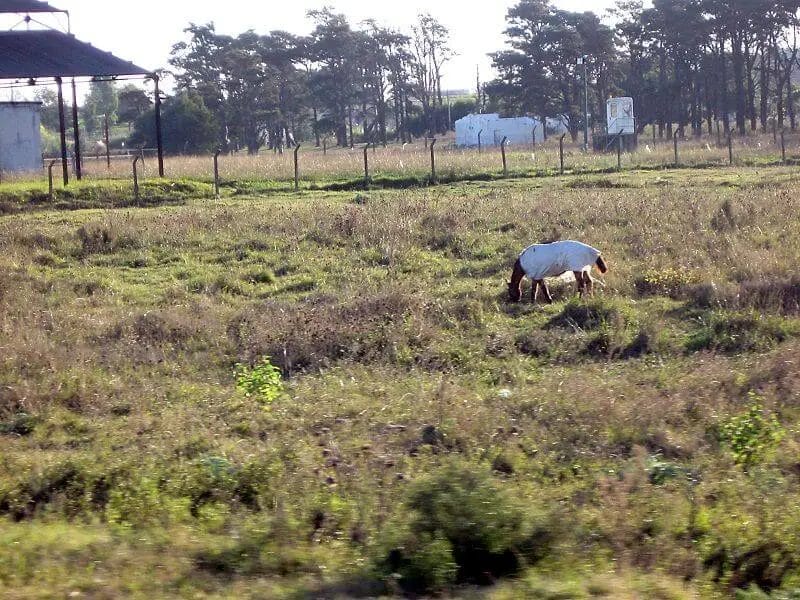After mowing, it is recommended to wait for at least 10-14 days before allowing horses to graze on the freshly cut grass. This waiting period ensures that any harmful chemicals or pesticides applied during mowing have dissipated, reducing the risk of ingestion and potential health issues for the horses. Additionally, allowing the grass to regrow and reach a sufficient height guarantees optimal nutrition for the horses as they graze.

Optimal Timing for Horses to Graze After Mowing
Proper pasture management is essential for the health and well-being of horses. One important aspect of pasture management is determining the optimal timing for horses to graze after mowing. This can greatly impact the nutritional quality of the forage and the overall health of the horses.
When it comes to mowing pastures, there are several factors to consider. The first is the growth stage of the forage. Different forage species have different stages of growth at which they provide optimal nutritional value for horses. For example, grasses are often most nutritious in the vegetative stage when they are young and actively growing. Legumes, on the other hand, may be most nutritious when they are in full bloom.
Once the pasture has been mowed, it is important to give the forage time to regrow before allowing the horses to graze. This allows the plants to replenish their energy reserves and ensures that the horses have access to high-quality forage. The amount of time needed for regrowth will vary depending on several factors including weather conditions, soil fertility, and the type of forage being grown.
Typically, it is recommended to wait at least 10 to 14 days after mowing before allowing horses to graze the pasture. This allows for adequate regrowth and ensures that the horses are not overgrazing newly mowed areas. Overgrazing can lead to decreased forage production, soil erosion, and the potential for nutrient imbalances in the pasture.
In addition to considering the regrowth period, it is important to evaluate the height of the forage before allowing horses to graze. Ideally, the forage should be between 4 to 6 inches in height. This ensures that the horses are not only getting enough to eat but also prevents them from selectively grazing and damaging the regrowth.
Timing is also important when it comes to the time of day horses are allowed to graze after mowing. It is generally recommended to allow horses to graze in the late afternoon or early evening when the temperature is cooler. This helps to reduce the risk of digestive issues such as colic and founder, which can occur when horses consume large amounts of fresh, lush forage too quickly.
In summary, determining the optimal timing for horses to graze after mowing is crucial for maintaining a healthy pasture and ensuring the nutritional needs of the horses are met. Waiting at least 10 to 14 days for regrowth, evaluating the height of the forage, and allowing grazing during cooler hours of the day are all important factors to consider. By implementing proper timing and management practices, horse owners can help promote the overall health and well-being of their equine companions.

Potential Health Risks for Horses Grazing Immediately After Mowing
When it comes to maintaining a healthy and well-maintained pasture for horses, proper grazing practices are of the utmost importance. One aspect that horse owners and caretakers should be aware of is the potential health risks associated with allowing horses to graze immediately after mowing. While it may seem convenient to let horses out to graze right after the lawn has been mowed, there are several factors to consider that could pose risks to the horses’ health.
1. Digestive Issues
One of the main concerns with allowing horses to graze on freshly mowed grass is the potential for digestive issues. When grass is mowed, the grass blades are cut into smaller pieces, making them easier for horses to consume. However, the rapid intake of large amounts of grass can lead to an increased risk of colic, a common and potentially life-threatening condition in horses. Horses that graze on freshly mowed grass may also be more prone to developing gas and bloating, which can further contribute to digestive discomfort.
2. Risk of Laminitis
Laminitis is a serious condition that affects the hooves of horses and can lead to extreme pain and lameness. Grazing on freshly mowed grass can increase the risk of laminitis in horses due to several factors. Firstly, the high sugar content in the cut grass can result in an overload of carbohydrates in the horse’s system, which can trigger the onset of laminitis. Additionally, the lush and tender grass that is present after mowing can be more palatable to horses, leading them to overeat and consume excessive amounts of sugar-rich grass.
3. Pesticide Exposure
Another potential health risk for horses that graze immediately after mowing is pesticide exposure. Many homeowners and caretakers use pesticides and herbicides on their lawns to control weeds, insects, and other pests. If horses are allowed to graze on grass that has been recently treated with these chemicals, they may come into contact with harmful substances. Pesticide exposure can lead to a range of health issues in horses, including skin irritations, respiratory problems, and even organ damage in severe cases.
4. Foreign Object Ingestion
Mowing can sometimes result in the presence of small debris and objects, such as rocks, sticks, or clumps of cut grass, in the pasture. Allowing horses to graze immediately after mowing increases the risk of them ingesting these foreign objects. Ingesting foreign objects can cause choking, gastrointestinal obstructions, and other internal injuries, requiring veterinary intervention and potentially leading to serious complications for the horse.
5. Allergic Reactions
Horses, like humans, can be sensitive or allergic to certain plants or grasses. When lawns are mowed, the release of pollen, dust, and other allergens into the air increases. Allowing horses to graze on freshly mowed grass can expose them to these allergens, potentially triggering allergic reactions. Symptoms of allergic reactions in horses may include respiratory difficulties, skin irritations, and swelling.
While it may be tempting to let horses graze immediately after mowing for convenience or to maintain a neat appearance, it is essential to consider the potential health risks involved. Digestive issues, the risk of laminitis, pesticide exposure, foreign object ingestion, and allergic reactions are all significant concerns that can arise from allowing horses to graze on freshly mowed grass. To prioritize the health and well-being of horses, it is recommended to wait for an appropriate period of time after mowing before allowing them to graze, ensuring a safer and healthier grazing environment.

Mowing and Grazing Best Practices for Horse Pastures
Proper pasture management is essential for maintaining healthy and productive horse pastures. One of the key aspects of pasture management is mowing and grazing practices. Knowing the best practices for mowing and grazing can help ensure that your horse pastures are in optimal condition for your horses to graze and thrive. In this section, we will discuss some of the best practices for mowing and grazing horse pastures.
Mowing Best Practices
Mowing is an important part of pasture maintenance as it helps control weed growth, promote grass growth, and maintain a desirable pasture height for your horses. Here are some best practices to follow when mowing your horse pastures:
- Mow at the right time: Mow your pastures when the grass is at the recommended height for your specific area. This will help prevent the grass from becoming too tall and fibrous, which can be less palatable for your horses.
- Remove clippings: After mowing, it is important to remove the clippings from the pasture. Excess clippings can smother the grass and create an ideal environment for weed growth.
- Mow at the right height: Set your mower to the recommended height for your specific grass species. Mowing too low can weaken the grass and leave it vulnerable to weed invasion, while mowing too high can result in a thatch buildup.
- Mow regularly: Regular mowing helps promote healthy grass growth and prevents weeds from taking over. Aim to mow your pastures at least once every two to three weeks during the growing season.
Grazing Best Practices
Grazing is a natural behavior for horses and can provide them with essential nutrients. However, proper grazing management is necessary to ensure that your pastures remain productive and sustainable. Here are some best practices for grazing your horse pastures:
- Practice rotational grazing: Rotational grazing involves dividing your pasture into smaller sections and allowing your horses to graze in one section while the others recover. This helps prevent overgrazing and allows the grass to regrow.
- Use a suitable stocking density: Avoid overstocking your pastures as it can lead to overgrazing and soil compaction. Follow the recommended stocking density for your specific pasture size and grass type.
- Monitor pasture condition: Regularly assess the condition of your pastures to ensure they are not being overgrazed. Look for signs of thinning grass, bare patches, or excessive manure accumulation. Adjust your grazing management accordingly.
- Implement rest periods: Periodically resting your pastures from grazing can help rejuvenate the grass and improve its overall health. Consider creating a sacrifice area where horses can be kept off the pasture during rest periods.
In summary, maintaining horse pastures requires proper mowing and grazing practices. Following the best practices for mowing, such as mowing at the right time and height, and removing clippings, ensures the health and productivity of the pasture. Implementing rotational grazing, using suitable stocking density, monitoring pasture condition, and implementing rest periods are vital for sustainable grazing. By implementing these best practices, you can create and maintain horse pastures that provide optimal nutrition and a safe environment for your horses.
Tips for Ensuring Safe Grazing for Horses After Mowing
Proper grazing management is essential for maintaining the health and well-being of horses. After mowing a pasture or field, there are several precautions you should take to ensure safe grazing for your horses. Follow these tips to prevent any potential health risks:
1. Wait for Sufficient Regrowth
Before allowing your horses to graze on a freshly mowed pasture, make sure there is sufficient regrowth. Waiting for the grass to grow to a minimum height of 4 to 6 inches ensures that it has recovered enough to provide adequate nutrition and prevent overgrazing. This waiting period allows the grass to replenish its energy reserves and establish a strong root system.
2. Remove Clippings and Debris
After mowing, it is important to remove any clippings and debris from the pasture. Horses may accidentally ingest clippings while grazing, which can lead to digestive issues such as colic. Clippings can also harbor mold or fungi, which pose a risk of mycotoxin ingestion. Use a rake or a leaf blower to clear the pasture of any leftover clippings or debris.
3. Monitor Grass Growth
Regularly monitor the growth of the grass in the pasture. If the grazing pressure exceeds the rate of grass growth, it can lead to overgrazing and nutrient depletion. Rotational grazing or using temporary fencing can help control the grazing pressure and allow the grass to recover adequately between grazing periods.
4. Consider Mowing Height
When mowing the pasture, consider the ideal mowing height for the type of grass present. Different grass species have different optimal mowing heights for optimal growth and regrowth. Mowing too low can weaken the grass and make it more susceptible to weeds and pests. Consult with a local agricultural extension office or equine nutritionist to determine the appropriate mowing height for your specific pasture.
5. Provide Supplemental Feed
In some cases, the regrowth of the pasture may not provide sufficient nutrition for your horses. If the grass is sparse or lacks essential nutrients, consider providing supplemental feed such as hay or grain to meet their dietary requirements. Consult with an equine nutritionist to determine the appropriate feed and feeding schedule based on your horse’s individual needs.
6. Regularly Inspect for Toxic Plants
Regularly inspect the pasture for the presence of toxic plants. Mowing can inadvertently expose horses to toxic plants that were previously hidden in taller grass. Remove any toxic plants promptly to prevent accidental ingestion and potential health issues.
7. Gradually Introduce Horses to Grazing
If your horses have been kept off the pasture for an extended period or are transitioning from a different diet, it is important to gradually introduce them to grazing. Gradual introduction allows their digestive system to adapt to the change in diet and prevents digestive upset. Start by allowing short grazing periods and gradually increase the duration as their system adjusts.
8. Practice Good Pasture Management
Implementing good pasture management practices year-round is crucial for maintaining safe grazing conditions for horses. This includes regular mowing, fertilizing, and weed control. By promoting healthy grass growth and minimizing the presence of toxic plants, you can ensure a safe and nutritious grazing environment for your horses.
In summary, ensuring safe grazing for horses after mowing involves waiting for regrowth, removing clippings and debris, monitoring grass growth, considering mowing height, providing supplemental feed if necessary, inspecting for toxic plants, gradually introducing horses to grazing, and implementing good pasture management practices. By following these tips, you can maintain a healthy and safe grazing environment for your horses.
FAQs
How long after mowing can horses graze?
Horses should not graze on freshly mowed grass for at least 24-48 hours. This allows the grass clippings to dry out and reduces the risk of colic caused by ingesting excessive amounts of wet grass. Additionally, it helps prevent the ingestion of potentially harmful chemicals or pesticides that may have been applied during mowing.
Conclusion:
In conclusion, it is important to consider the safety of horses when allowing them to graze after mowing. While there is no definitive time frame, experts recommend waiting at least 24-48 hours after mowing before allowing horses to graze on the grass. This allows any potential toxins or irritants from the freshly cut grass to dissipate. Additionally, regularly monitoring the condition of the pasture and ensuring it is free from harmful plants or excessive weed growth is essential for maintaining the health and well-being of the horses. By taking these precautions, horse owners can create a safe grazing environment for their equine companions.
